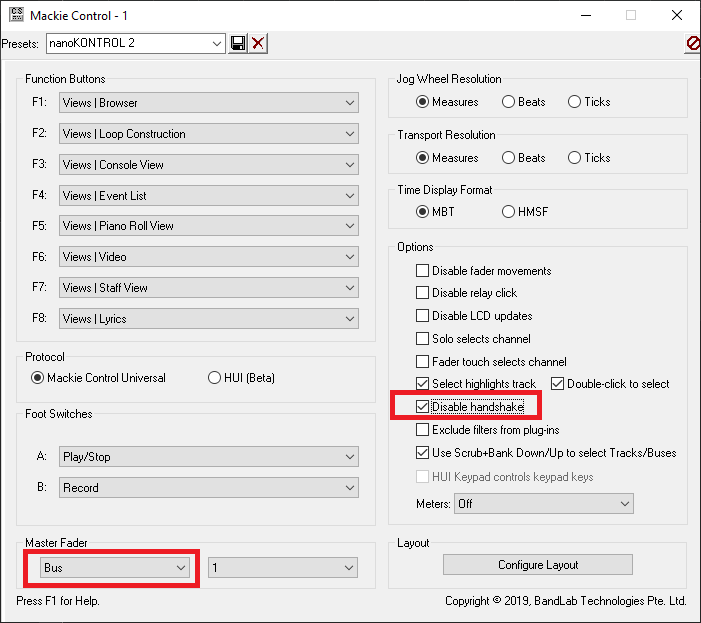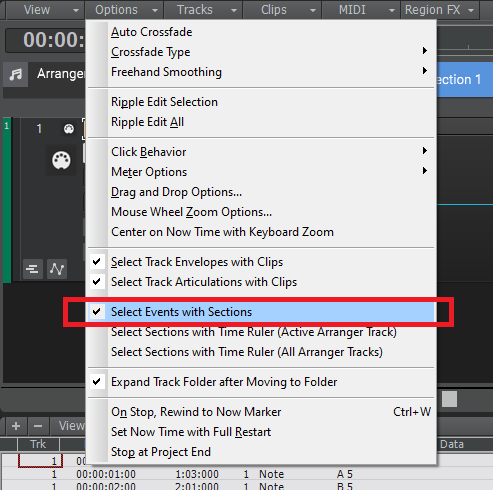-
Posts
6,128 -
Joined
-
Last visited
-
Days Won
26
Everything posted by msmcleod
-
The other thing that can stop Cakewalk starting is a corrupt ctrlsurface.dat file. It's located in %APPDATA%\Cakewalk\Cakewalk Core\ You could try deleting that to see if it helps.
-
Check that you've not got any .zip files on your desktop. If you have, move them to a different folder.
-
Are you definitely on the latest version ( 2022.02 build 39 ) ? This was previously an issue in the 2021.12 release.
-
Only the export filename, location and audio export settings are saved with your project. The following are not: 1. Any specific items checked in "What to Export" 2. Your selection / selection range. If you need those to be saved too, save your export as a task.
-
Have you tried checking "Disable Handshake" in the Mackie Control Surface dialog within Cakewalk? You can get to this dialog from the Utilities menu.
-

Commit arrangement loses first midi note
msmcleod replied to musekamp's topic in Cakewalk by BandLab
Ok, tracked down the issue - if "Select Events with Sections" is turned off in the select module, commit arrangement doesn't work properly - this is the cause of everything being off by 1 tick. I'll fix the commit arrangement command for the next release to ensure this is switched on for the duration of the commit command, but in the meantime, please ensure this is switched on before committing an arrangement: -
That is strange, because I tried that setting too and still couldn't reproduce. I'm sure there is something else at play here, because even with that setting it shouldn't be shifting things they way they were for you.
-

Commit arrangement loses first midi note
msmcleod replied to musekamp's topic in Cakewalk by BandLab
@musekamp - I can't reproduce this issue using the steps provided. Can you post two copies of the project where this is happening ( before & after the issue ) so we can look into it? -

Weird line marker appearing in Track View
msmcleod replied to Lost Phases's topic in Cakewalk by BandLab
I'd go as far to say as it's required for DAW's... unless you're just doing hours of PRV editing on a train or something. -
I'm not 100% sure, but I think all that switching off auto-updates does is tell it not to install the updates, I don't think it stops Windows from downloading them for you.
-
@winkpain - any recent graphics driver updates? You could also try running Cakewalk using the internal Intel graphics card to see if its any different. FWIW, I've got Cakewalk running on an 3rd gen i7 and 3rd gen i5, both running at 3.4GHz, and both using the onboard graphics, and have no issues with either, hence my suggestion.
-
Whenever this has happened to me, it's been Windows Update downloading stuff in the background, or Windows Defender deciding to do a scan. I'm normally pretty pro-active about manually checking for updates and installing them when they appear, so I don't often get this issue. But if I forget for a few days, this comes up every now and then.
-

Multi Track Automation To One Kontakt VST Instance
msmcleod replied to Christopher Russell's question in Q&A
@Christopher Russell - can you confirm whether you're using a track template or a project template? -
If you mean BandLab assistant, the easiest way to get around this message is to download it again from the bandlab website (i.e. not via an update in the app itself), and re-install it. FWIW, unless you're using the BandLab loops, there's no reason to ever run BandLab assistant or even have it installed. Apart from the loops, everything else it does for Cakewalk can be done within Cakewalk itself.
-

How to Slow Down Backing Tracks for Practice and Avoid Dropouts
msmcleod replied to Jamie Rosen's question in Q&A
If the backing track is a single audio file, the easiest way is to hold CTRL+SHIFT to stretch the clip: If you want to do it in an existing project, bounce the tracks to a new track and solo the new track. You can then stretch it while you practice until you're ready to record. -

Multi Track Automation To One Kontakt VST Instance
msmcleod replied to Christopher Russell's question in Q&A
I'd normally recommend the MIDI mapping method you've described for automating a single instance of Kontakt over several tracks. The MIDI mapping should persist after project reload, and this is certainly working for me on the instruments I've tried this with. Can you confirm whether your issue is limited to the Nucleus library, or is it an issue with other instruments? -
FWIW I use the 18i20 and have no issues with it at all. I normally record at a buffer size of 64. +1 to both @Promidi & @Lord Tim 's suggestions. The beta drivers have been much more reliable for me ( I was getting occasional BSOD's when changing buffer size in the official ones ). Turning off the USB power suspend / ensuring you're running in High Performance mode is a must.
-

sending 8 live tracks from zoom r24 at once to be recorded to cakewalk. how?
msmcleod replied to iamsteve71's question in Q&A
AFAIK, the Zoom r24 ASIO driver supports 4 stereo ASIO inputs (i.e. 8 mono tracks), and 1 stereo output. You need to: 1. Ensure you've downloaded & installed the latest r24 ASIO driver 2. Make sure Cakewalk is set to ASIO mode in Preferences->Audio->Playback and Recording 3. Enable all of the R24 ASIO inputs in Preferences->Audio->Devices 4. Ensure each track you're recording has its input port set to the correct ASIO input port. Apart from that, the only thing that is needed is to set up the routing in the R24 to ensure each track is sent to the correct ASIO port.- 1 reply
-
- 1
-

-

Recording and playback freezes with new U-Phoria audio interface
msmcleod replied to nkeelaghan's question in Q&A
Other things: +1 to @scook's and @rfssongs suggestions - you want to be using the official ASIO driver from Behringer, and running in ASIO mode, and using a high quality cable. Uninstall any "generic" drivers such as ASIO4ALL or the generic ASIO drivers from Steinberg, Reaper, MAGIX or FLStudio - they are not needed if you have a real ASIO driver, and can interfere with your main ASIO driver. If you're using a laptop, ensure you are running in High Performance mode - turn off any battery saving features. It's better to record at a lower buffer size than 4096. Personally, I record at a buffer size of 64, but 128 or 256 should be fine too. Make sure your all Cakewalk folders ( e.g. global audio folder, project folders & any plugin folders ) are excluded from any virus checkers or cloud sync devices. If they are trying to access the wav file Cakewalk is saving to during recording, it could cause dropouts at best, and even worse crashes. -
IIRC Antress did actually recently release their plugins as 64 bit, however it looks like their downloads have been removed: http://antress.blogspot.com/ - I don't know if this is a temporary glitch or not. [EDIT] - Apologies... I got them mixed up with Variety of Sound, which did re-release their plugins as 64 bit.
-

Recording and playback freezes with new U-Phoria audio interface
msmcleod replied to nkeelaghan's question in Q&A
The UMC404HD has 4 mono inputs and 4 mono outputs, i.e. 2 stereo in / 2 stereo out. As for the freezing, it's difficult to tell as it seems you've got drop-out notifications switched off. The drop-out code on the notification will tell you why it's dropping out. -

Huge problem with the Tempo Map and audio following tempo changes
msmcleod replied to Olaf's topic in Cakewalk by BandLab
The tempo track shares the same envelope editor as the automation lanes. When using jumps in automation, the dotted lines literally mean no automation at all. This means if you started a project in the middle of a dotted area, no automation would be sent out until it reached a node. Obviously you can't have an area in the project with no tempo, so for tempos, there's pretty much no difference between a jump and a straight line. It's really down to how you want to work. Multiple nodes at the same position should in most cases end up being merged into one node. If in doubt, refer to the Tempo Inspector to see if the list of tempos makes sense - and of course, there's nothing wrong with deleting nodes / changing them to jumps if you want to. Obviously, if the rare case when you start seeing strange envelopes being drawn with nodes / lines in the wrong place, this is a bug - the easiest way around this is to simply delete the offending nodes. FYI - this is how the tempo track works: 1. The tempo stream contains shape events in exactly the same way as an automation lane contains shapes. 2. When you change the tempo envelope, behind the scenes a linear list of tempo changes ( the tempo map ) is regenerated based on snapshots of the tempo envelope at regular intervals. By default this is every 1/16th note, although it can be changed in Cakewalk.ini to be a higher resolution using the TempoMapDecimationResolution setting. 3. The resultant tempo map is exactly the same tempo map used prior to the introduction of the tempo track. 4. Saving a project saves both the tempo track envelope and the tempo map. This approach has several advantages: 1. The vast majority of the code didn't need to be changed, as it's referring to exactly the same tempo map as it did before. In other words, the tempo track is used for only as an editor for the tempo map, and only the tempo map is used when playing, or whenever edit operations need to calculate the current tempo - just as it did before. 2. Projects remain both forward and backward compatible with SONAR and earlier versions of CbB : Backwards compatible, because we can generate a tempo envelope from an existing tempo map if a tempo envelope doesn't exist; forwards compatible because there's always a tempo map stored with the project - earlier versions will simply ignore the tempo envelope stream. 3. We can use the same envelope editor for the tempo track as we do for automation envelopes. For the most part the tempo track envelope is king, and the tempo map is only generated from the tempo track envelope. There are a few exceptions where the opposite happens - i.e. the tempo map is manipulated directly and the tempo track envelope is then regenerated from the map: Loading older projects that don't have a tempo track envelope Set Measure / Beat at Now Tempo detection from audio - either through AudioSnap, or using Melodyne (drag audio track to time ruler) In these cases, separate Cakewalk.ini variables are used to determine the resolution the envelope should use. The ini file settings are documented here: http://www.cakewalk.com/Documentation?product=Cakewalk&language=3&help=Tempo.15.html -
1. Yes, you can produce professional music, but bear in mind the BM800 is very much an entry-level microphone. It'll take some practice to get your vocal recording / mixing technique to sound how you want it to. The BM800 can sound quite harsh in the upper mids, so you may need to tame them a bit with EQ. The ProChannel EQ is more than capable of this. This is a good starting point: https://youtu.be/qdDDVortvRU 2. The best way to double vocals is simply to record it again on another track. There are double-tracking plugins you could use, but you may find phase issues with them translating to Mono ( i.e. someone listening through their iPhone speaker ).






